|
|
We must have pictures! No amount of description can "sell" your property.
The web has changed the way that location-finders conduct their business, and our clients
visit our web library needing to see what your location looks like.
We don't necessarily expect professional quality photographs, but the pictures must be good.
A film company or photographer is often working to a deadline: if it comes to a choice between
locations, it may well be the quality of the images that decides one over the other.
Dark or fuzzy pictures will frustrate rather than entice; a picture of a favourite vase does not impart the
quality of the room it's in.
So what to do?
Modern digital cameras, used with a little care, can provide excellent results.
Here's a few pointers:
:: set the camera for 'medium' or 'large'
Please supply pictures which are at least 1200 pixels wide. (Please note! We no longer accept anything other than digital images.)
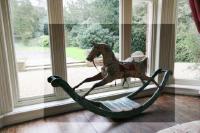
:: wide angle lenses
Used carefully, a wide angle lens can show much more of a room than a normal lens.
But there are dangers:
:: a small room can be made to appear much larger than it really is;
:: the image can look distorted.
To avoid distortion, shoot with a standard lens whenever possible, moving the camera further back to get the same view.
When using a wide angle lens, ensure that the camera angle is level (i.e. horizontal)
so that the verticals appear upright through the viewfinder.
:: hold the camera steady
If you can't use a tripod, use a monopod. If you can't use a monopod, hold the camera as steadily as you can,
in order to get the sharpest pictures.
:: use available light
Always photograph interiors in daylight, and try to avoid using a flash.
The light coming in the window is the best light possible, and your pictures will most closely resemble what the eye can see.

:: shoot "landscape"
All of television and film, and the majority of stills photography, is shot using a 'landscape' format - avoid shooting 'portrait'.
:: no snow!
No matter how beautiful your house or garden appeared in last winter's snow, you cannot reasonably expect a film-maker
or photographer to turn up and expect to find the same scenes; in fact, we usually discard snowscapes (and Christmas interiors). By all means photograph your garden when the leaves have all gone, but it would be preferable to use pictures of the exterior in spring or summer (and the interiors after the Xmas tree has gone!)
|
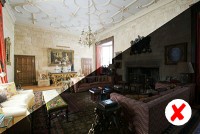
too light/too dark
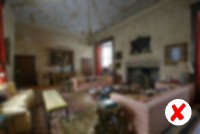
not sharp
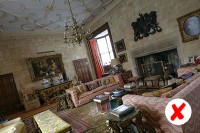
squint
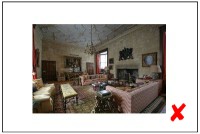
too small

too close

avoid portrait

just right!
| |
:: what to shoot
The pictures that end up on our web site will tell a story: as though we are being welcomed into your home:
:: first pictures are of the exterior as though we have just arrived (first impressions - from the street, garden path, front door);
:: we are then welcomed in to the premises (downstairs hall);
:: offered a cup of tea (living/sitting room);
:: then shown around (dining room, TV lounge, kitchen);
:: taken upstairs (bedrooms, bathroom, study, gym);
:: and finally the garden (patio, summerhouse).
Although you may not necessarily be taking the pictures in this order, this is how they will be presented in the web library.
|
How to make our life easier:
:: get the shots in order: avoid the temptation to rename the shots descriptively. You'll end up with the shots
being ordered alphabetically, which from our perspective means they're all mixed up. If you renumber them, use numbers like '019', '020', '021' etc, because computers do stupid things like this: '19', '2', '20'.... Or the best of both worlds: '019_Stair', '020_Bedroom', '021_Bathroom'.
| |
As an example, take an "ordinary" living room:
:: This room has a door, two bay windows and a fireplace.
:: Start by taking a picture from the doorway: this is what you would see when you first enter the room;
:: then shoot the room from each of the corners, to ensure that every possible corner is being shown.
|
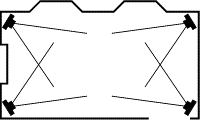
|
:: Then photograph any features of the room which are exceptional,
for example the fireplace, the settee, the view out of the window, or the piano in the corner.
Ensure that any special features are photographed "straight-on" so that they are the centre of attraction.
|
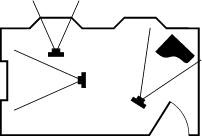
| |
Be sure to cover features which make your location unique - the stained glass window, the secret passage,
or the folly in the garden. Sometimes it can just be a wall or a door which captures a mood, for example faded grandeur.
The clearer your photographs, the better the chance they will sell your property to our clients.
Don't be afraid to picture the same scene from different angles. Clients want a realistic depiction of a
location, warts and all, not just the pretty angles!
Don't photograph the chairs on either side of the fireplace - we need to see the fireplace too.
If the roof is easily accessible, photograph the roof. If it involves climbing gear, or requires health and safety
training, don't bother: if you can't do it easily, it will be ten times more difficult for a film crew.
| |
:: how many pics to shoot
Shoot as many as you like, a hundred if necessary (although do remember that the more editing we have to do,
the longer it may take before your pictures are uploaded).
There is no particular cost involved when using digital, and we will pick the shots that we think represent your location in the best light.
If we show your pictures to a client, and they ask "what's round that corner?", you haven't photographed the location sufficiently.
| |
WARNING
Unfortunately we are inundated with applications to join our library, so we apply strict criteria for acceptance. We will review every application, but it will be rejected if:
:: the pictures are too small / not digital / not landscape;
:: pictures are out of focus / badly exposed;
:: there are too few pictures;
:: your description mentions features that are not included in the photographs;
:: your property is of a type (and in an area) which is already well represented in our library.
We will always welcome a location that is photographed well: it makes our life so much easier.
|
<< previous | next >>
terms & conditions
|

